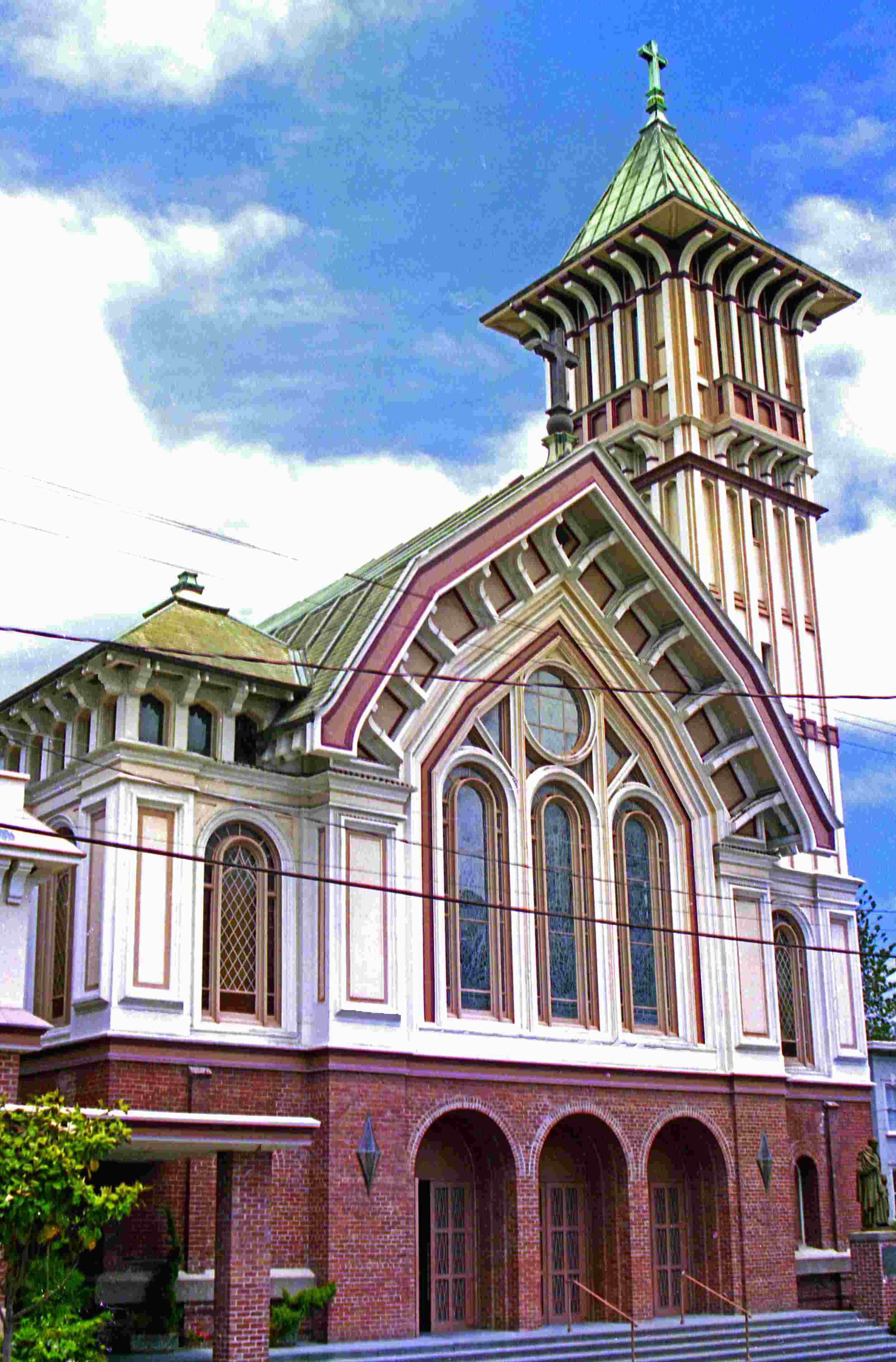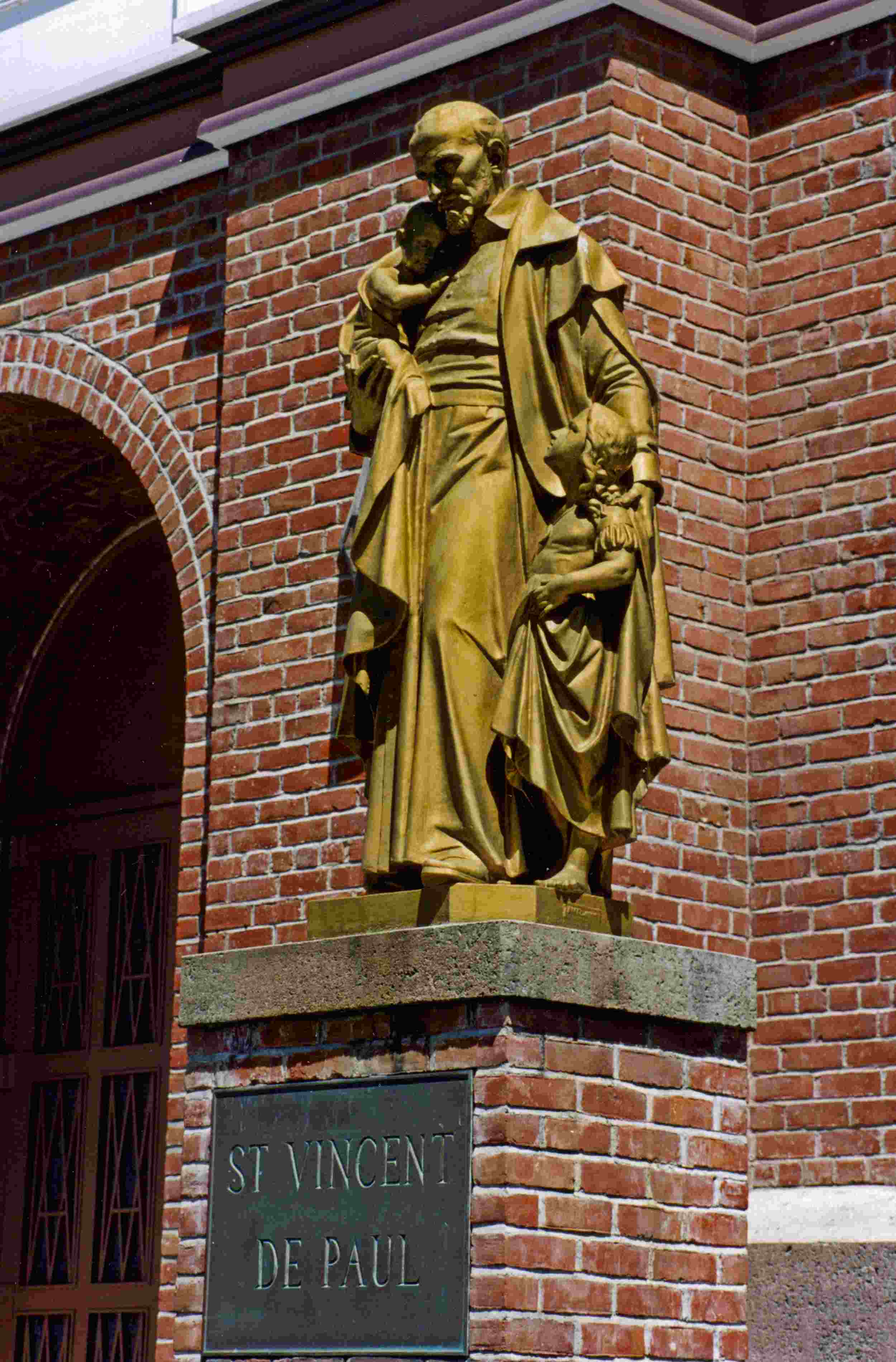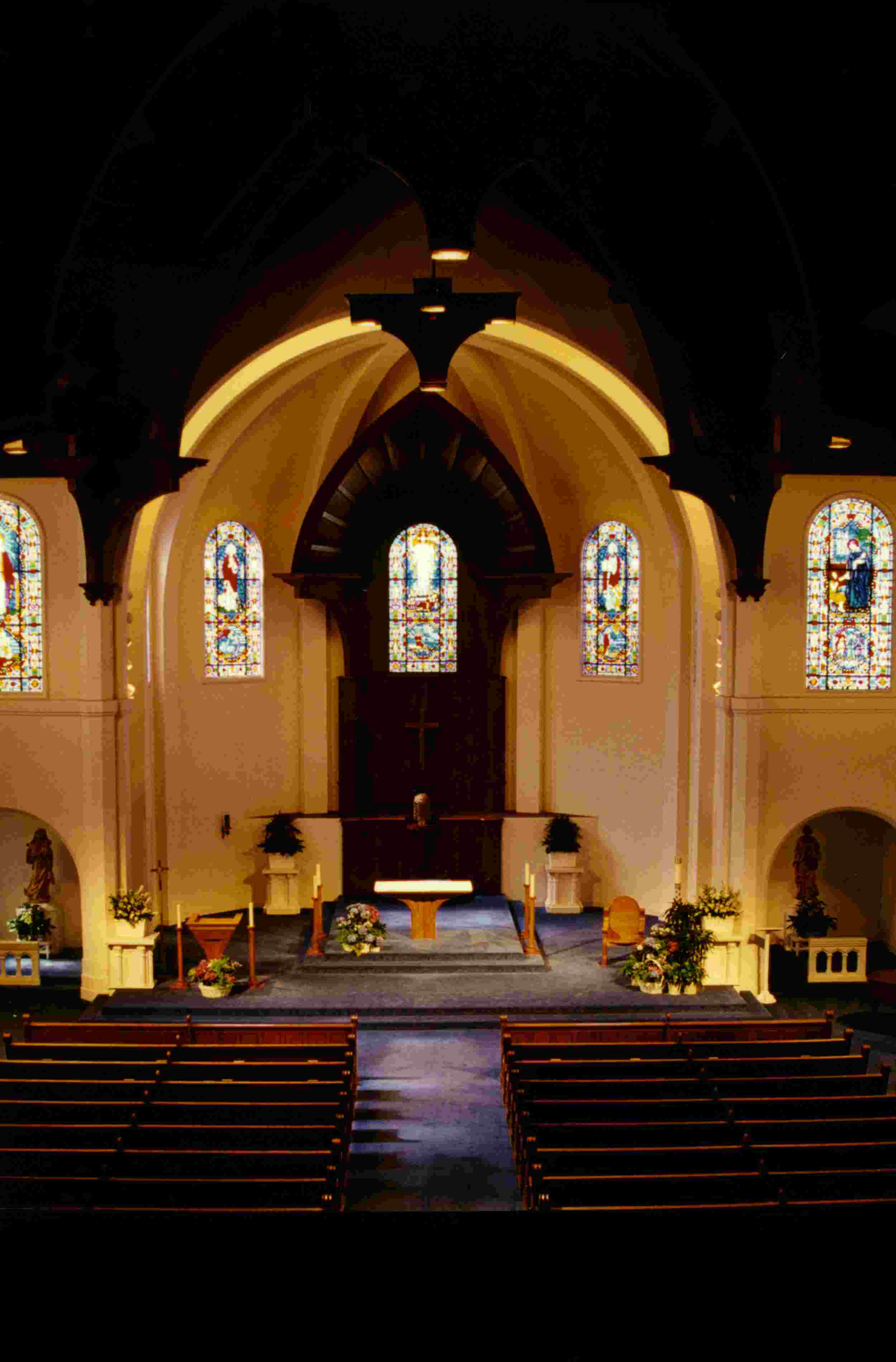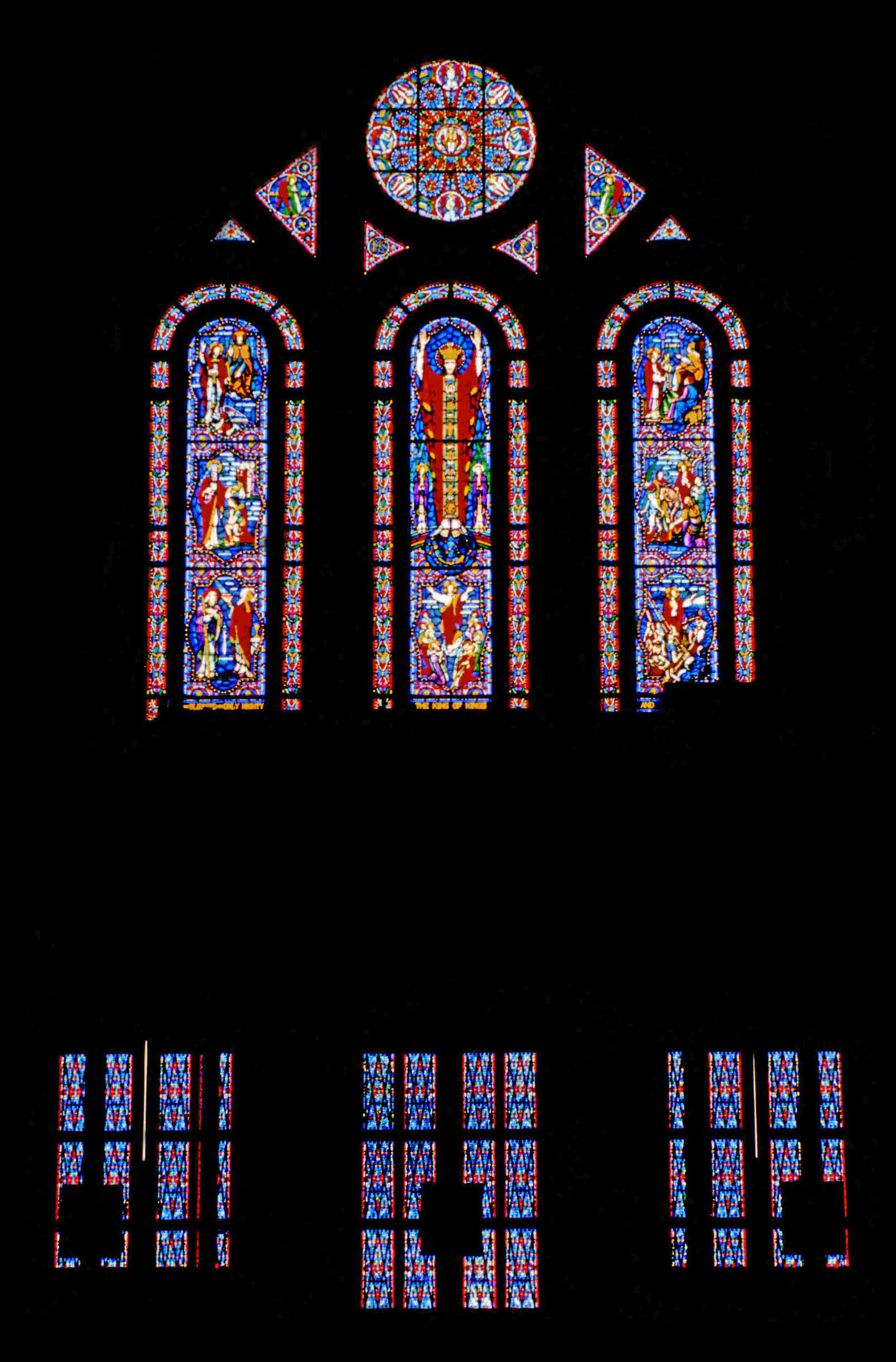Saint Vincent de Paul Church
2320 Green Street
San Francisco
Stepping from the busy urban streets of Cow Hollow into the Church of Saint Vincent de Paul transports you to a realm of heavenly blue. The incredible sensory impact of the Chartres blue stained glass windows in the darkened church dazzles your mind. As you turn in every direction to catch the play of color in the sunlight, it takes several minutes before you begin to focus on the individual stained glass windows, which contribute so stunningly to the overall effect.
Saint Vincent de Paul Church was completed in 1913, just twelve years after the parish was founded and just seven years after the great San Francisco earthquake of 1906. The architects, Frank T. Shea and John D. Lofquist, designed a structure with campanile, using brick and California redwood, with the opportunity for art glass effects. Although described as “modified Gothic,” the church would be very much at home in an Alpine village. Its steep roof, deep overhangs, and prominent bell tower provide a unique, pleasing contrast to the Victorian and early 20th century buildings in the neighborhood.
The art glass effects envisioned by the architects would take a long time, but would be worth the wait. More than thirty years, and two World Wars after the church was dedicated, work on the stained glass windows began. Father James H. Long, the pastor of Saint Vincent de Paul, had a clear idea of the theme for the windows. The designer/craftsman selected to create the windows was an unknown San Franciscan, Carl Huneke. Mr. Huneke was born in Achim bei Bremen, Germany in 1898. He started his stained glass career as a 13-year-old apprentice in Bremen, Germany. He was a bright student who had been offered a scholarship to continue his academic studies. However, he had to contribute to his family’s income, since his mother was a widow with nine children. He loved art and eagerly applied himself to stained glass. In 1925, he immigrated to San Francisco and was employed by Edward La Potka at Church Art Glass Studio. For the next several years, Mr. Huneke studied English and oil painting at night school. He prospered in his occupation until the Depression. There was no work in stained glass for several years. To survive the Depression, Mr. Huneke and his wife, Lee, started a small neighborhood grocery store.
The one brief bright spot during the Depression years occurred in 1931. Charles Connick, the renowned Boston stained glass artist, created stained glass windows for Grace Cathedral. By chance, he hired Carl Huneke from the union hall to assist in the installation of those windows. From that incidental contact, the two men developed great respect for each other.
In the late 1930’s, stained glass work revived and Mr. Huneke was called back to work at Church Art Glass. He soon became principal artist for that firm. During creation of windows for Saint Mary of the Annunciation Church in Stockton (now Cathedral of the Annunciation), the imperious Monsignor William E. McGough fired the firm, but insisted that Carl Huneke stay on to complete the windows in the church. Reluctantly, Carl Huneke acquiesced, and Century Stained Glass Studio was born. The stained glass windows created by Mr. Huneke for the new Saint Mary’s were a great success, partly because the charming young principal of the grammar school, Sister Maurice Powers, O. P., mediated between the demanding monsignor and the quiet, humble artist who spoke with an accent. Sister Maurice became a life long mentor and confidante to Mr. Huneke and his family.
Work on Saint Mary of the Annunciation was not quite complete when Mr. Huneke accepted the task of putting Father Long’s visions for Saint Vincent de Paul into glass, paint and lead. Charles Connick recommended Carl Huneke for the job. The contract for the first window was signed in November 1944. Father Long liked the Gothic Revival windows proposed by Mr. Huneke. They agreed that the color tones should be dominantly blue. Mr. Huneke experimented with 8 x 10 black and white photos of existing stained glass windows. Using a fine tipped camel hairbrush, he applied enamel paint to each individual segment of glass in the photo to achieve the balance of blue, with red, yellow and green accents. Several of those experimental miniatures still exist.
Century Stained Glass Studio was located in a tiny space at 374 Fillmore Street. That space was sufficient for a workshop large enough to lay out individual sections of the large windows at St. Mary of the Annunciation and Saint Vincent de Paul, but was not large enough for an entire window. The same was true for the glass easel, which stood upright in the shop. Each piece of glass was waxed onto that easel, was painted or stained, then was removed for firing in a kiln to fuse the stain permanently into the glass. Great care was taken to match the continuity of the panels in geometry, color and intensity without ever seeing them together until the final installation in the church. The shop was too small for the kiln. It was located in the back room of their grocery store at the corner of Page and Lyon Streets. Mr. Huneke had built the kiln himself with advice from Charles Connick and assistance from an engineer at P. G. and E.
Mr. Huneke did not drive until a year after he started the windows at St. Vincent de Paul. He enlisted his retired father-in-law to drive the painted glass from the studio to the kiln each afternoon and to pick up the fused glass each morning to return it to the shop for leading.
Through ingenuity and diligence, Mr. Huneke surmounted the challenges of starting a new stained glass business during the war years. He found lead and solder for the windows when metal was scarce. He arranged gasoline for transportation when it was rationed. He got shipments of glass from the East Coast when rail and highway shipping space had military priorities. All new stencils for borders and backgrounds for the windows were cut square inch by square inch. He completed research into the accoutrements, symbols, icons, colors, and representations traditionally presented with each saint or event depicted.
Mr. Huneke bought a second hand projector. Each night at home, he projected his small pencil sketches or pictures gleaned from reference sources onto the wall of their rented flat in the Haight-Ashbury. The image, projected onto a large sheet of blank butcher paper tacked to the wall, was re-sketched full window size for the cartoon. The cartoon became the plan for cutting the glass and assembling the window.
The first window installed at St. Vincent de Paul was the Christ the King window in the choir loft at the rear (south wall) of the church. It was a triptych – three panels in each opening with borders, accents, and a rosette at the apex. The panels include both Old Testament and New Testament events relating to The King of Kings. The central figure is Christ, garbed in red, with arms extended overhead. This window is one of only a dozen or so signed windows. Carl Huneke was not comfortable with “advertising” in his stained glass windows. When asked why he did not sign more windows, this humble artist responded facetiously, “They all know the great ones.”
The Nativity window in the west transept and the Crucifixion window in the east transept followed with contracts for each signed on July 20, 1945. Like the Christ the King window, the Nativity and the Crucifixion are triptychs, consisting of nine panels. They include borders and accents, and are surmounted by rosettes. Old Testament prophesies of the event are on the left, and New Testament fulfillments of the event are on the right.
The center panel of the Nativity window is a lovely scene of Mary and Joseph in the stable with the Christ Child resting, comfortable and secure in the manger. Mary’s expression is serene and adoring. Joseph is relieved, protective and watchful. These figures exhibit the trademarks of Carl Huneke’s artistry: soft angelic faces, graceful hands, and flowing folds in garb.
In the Crucifixion window, the central panel shows a dying Christ on the cross. His spirit, about to leave his body radiates outward to heaven and earth. Beneath the cross, his stricken mother is comforted in her grief, and the Apostle, John, implores compassion.
Each of these three windows, Christ the King, The Nativity, and The Crucifixion, is larger than an average living room. The overall dimensions are approximately 20 feet wide by 25 feet high. They each contain more than 3000 individual pieces of glass carefully held in place by H bars of lead, soldered securely to the surrounding pieces Many of the individual pieces of glass have been painted with stain or black to produce the intricate patterns or shading through which the artist develops the scene. The scale of these three windows is equal to windows in the great cathedrals of Europe. The artistry and the message of each of these three windows at Saint Vincent de Paul, fulfills the concept of those thousand-year-old windows in Europe.
Mr. Huneke was uncomfortable with written contracts, and the remaining windows at St. Vincent de Paul were completed under verbal agreements. In the clerestory above the pews, five windows line each side of the nave from the choir to the transept. Each of those 5 foot wide by 12-foot high windows contains a New Testament event and a smaller medallion with a related Old Testament event. The Beginning of Miracles in Cana window (fifth on the left from the choir) is an excellent example. In his book, “One Hundred Years, The Church of St. Vincent de Paul, San Francisco, 1901 – 2001”, Reverend John Kevin Ring, Pastor of Saint Vincent de Paul Parish eloquently comments on the scriptural content of this window:
“‘These very works that I do bear witness to me.’ ‘Dost thou not believe that I am in the Father and the Father in me? Believe because of the works themselves,’ Men believe another when they are convinced that he is an honest man. Jesus did not disdain to give men many evidences of the fact that He is Truth Itself. His miracles are His way of irrefutably showing men that He is the Eternal Son of God. In the window, … the scene is the miracle at the marriage feast in Cana. The main reason for the choice of this subject is to present a miracle of Christ, to show forth the more, His Divinity. Yet this particular scene is a happy choice for still another reason: it shows the high esteem in which our Lord held marriage, His love for the little people of this world, and even His approval of innocent enjoyment. The symbol on the shield in the border of the window refers to marriage: the ‘chi – rho’ (XP) symbolizes Christian Marriage: Christ, husband, wife.
The medallion for this window shows Moses, after he had struck the rock with a rod, at the bidding of God. Water miraculously pours forth. The Jewish people, in their desert journey from Egypt to the Promised Land, were parched with thirst, and were complaining. Moses begged God’s help. This particular scene shows very well that it is God alone who works miracles. Saints work them in the name and by the power of God. Christ works them in His own name, for He is God.”
Thirty-nine stained glass windows were completed by 1948, and the intent of the architects’ had been fulfilled. However, the work continued. Two more windows were added in the bell tower between 1958 and 1960. In 1961, the final touch was the addition of 36 leaded panels in the front doors. These small panels are exquisite graphic art as well as a tantalizing treat for the eye. The bold cames of lead form the letters A, M, and V for Ave Maria, Virgin Mary and Vincent. Each panel, less than two and one half square feet, contains more than 300 individual pieces of glass. This masterpiece of architectural glass may be unsurpassed in any church in the world. Upon entry to the church, the radiant beauty of these panels is reflected in the clear glass screen separating the vestibule from the nave. They are also the last vision upon leaving the church.
This was only the second church in which Mr. Huneke designed and installed windows. During the 30-year existence of Century Stained Glass Studio, he went on to create about 1200 windows in 80 churches. Most of those were Catholic churches in the Archdiocese of San Francisco. Four generations of Mr. Huneke’s family have admired his work at St. Vincent de Paul. His great-granddaughter Mia Blaine was baptized in the bapistry. His great-granddaughter, Laura Moir Odujinrin, attended and graduated from St. Vincent de Paul School.
Stained glass is a collaborative creation. It includes architects, who provide the opportunity to display unique artistic creations. It is made possible by pastors who designate the time and commit the funds, and often establish the theme. It is funded by generous, altruistic donors. It is conceived by the artist, and assembled by the artisans. However, it also requires those who appreciate the final result and are inspired by it.
In his book, “Adventures in Light and Color,” Charles Connick wrote: “…to the devoted craftsman in glass…successful designs have always been made for light, as great musical composers’ arrangements have been made for sound…and at its best, stained glass is the greatest medium for significant beauty in the world.”
Visit the Church of Saint Vincent de Paul, a superb example of “the greatest medium for significant beauty”. A new and different exhibition occurs with every change in the light, hour-by-hour, day by day, weather pattern by weather pattern. This exhibition is open daily, and it is free. After you have been overwhelmed by the spiritual ambiance, begin to look for the exquisite details, absorb the message – miracles will happen.
The Church of Saint Vincent de Paul is located at 2320 Green Street, the corner of Green and Steiner, in San Francisco.
The author, Terry Blaine, is a businessman in Menlo Park. He occasionally assisted his father-in-law, Carl Huneke at Century Stained Glass Studio, and in installations of windows. Since 1993, as time permitted, he researched and photographed Mr. Huneke’s stained glass windows.




